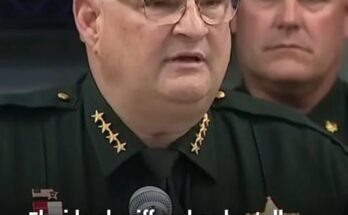The internet has erupted once again with theories about Donald and Melania Trump’s relationship, this time focusing on a peculiar photograph that has sparked everything from concern to conspiracy theories. The image, captured as the couple left the White House for their high-profile evening at the Kennedy Center, shows what appears to be an awkward moment of public affection that has become the latest talking point in the ongoing speculation about the state of their marriage.
The Incident That Started a Thousand Theories
The photograph in question was taken on June 11, 2025, as Donald and Melania Trump departed the White House to attend the opening night performance of “Les Misérables” at the Kennedy Center. In the image, the First Lady can be seen extending only her thumb to her husband, who grips it in what many observers have described as an uncomfortable and unnatural hand-holding position.
The awkward thumb-grip was captured by photographers as the couple made their way to their vehicle, with Melania leading the way and her thumb extended in what appeared to be a carefully controlled gesture. The image quickly went viral on social media platforms, generating thousands of comments and spawning numerous memes and theories about the couple’s relationship dynamics.
What makes this particular incident so fascinating to observers is how it seems to encapsulate years of speculation about the Trump marriage. The photograph has been dissected by body language experts, relationship counselors, and armchair psychologists, all trying to decode what the unusual hand-holding technique might reveal about the couple’s private dynamics.

Trump can be seen holding his wife’s thumb (ALEX WROBLEWSKI/AFP via Getty Images)
A Pattern of Public Displays of Discomfort
This latest incident is far from isolated in the Trump marriage narrative. Social media users and political observers have been documenting what they perceive as Melania’s reluctance to engage in public displays of affection for years. The Kennedy Center thumb-holding incident has simply added another chapter to a long-running saga that has captivated the public imagination.
The most infamous of these moments occurred back in 2017 during a visit to Tel Aviv, Israel, when Melania was caught on camera appearing to swat away Donald’s hand as he attempted to reach for hers while they walked a red carpet. The incident was broadcast live and quickly became a viral moment, spawning countless memes and analysis pieces about the state of their relationship.
Similar incidents have occurred throughout Trump’s political career. During the final presidential debate in 2020, cameras captured what appeared to be Melania swiftly pulling her hand away when Trump attempted to grab it. More recently, as the couple left the White House for the Capitol during inauguration events, observers noted another instance of apparent hand-swatting, according to reports from multiple news outlets.
These moments have become so frequent and notable that they’ve earned their own category in political commentary, with journalists and social media users regularly documenting and analyzing each new instance of what they perceive as marital tension played out in public.
The Context of the Kennedy Center Visit
The couple’s visit to the Kennedy Center was particularly significant, as it marked Trump’s first attendance at a show there since becoming president, reflecting his focus on remaking the institution after taking control of it earlier in the year. The evening was meant to serve as a high-profile fundraiser for the financially struggling arts center, with guests paying up to $2 million for premium experiences.
The event was contentious from the start, with Trump having recently installed his allies on the Kennedy Center board and appointed himself as chairman. At least 10 to 12 performers from the “Les Misérables” cast had chosen to boycott the performance specifically because of Trump’s attendance, adding an extra layer of tension to the evening.
When the couple arrived at the Kennedy Center, they were greeted with a mix of cheers and boos from the audience. During intermission, the tension escalated when a woman in the orchestra section began yelling “Felon, you’re a convicted felon” and “Convicted felon, rapist!” before being escorted out by security.
The thumb-holding photograph takes on additional significance when viewed against this backdrop of public controversy and political tension. Some observers have suggested that the awkward physical gesture reflects the broader strain the couple may be experiencing as they navigate the intense scrutiny and polarized reactions that follow them wherever they go.
Social Media Erupts with Theories
The viral photograph has generated a flood of creative and often humorous theories about what the thumb-holding might represent. Social media users have approached the image with a mixture of genuine concern, political commentary, and satirical humor that reflects the deeply divided nature of public opinion about the Trump family.
One of the most popular theories suggests a transactional interpretation of the gesture. Critics have jokingly proposed that Melania operates on a “sliding scale” for physical contact, with different prices for different levels of intimacy. “He grabbed a thumb because he couldn’t afford to pay for the whole hand,” one user quipped, while another elaborated: “There’s a sliding scale for hand holding photo ops with Melania. Thumb goes for 10k. Thumb and index goes for 20K. Whole hand but for only 5 minutes, 50K.”
Other users have focused on the physical aspects of the interaction, with some expressing concern about Trump’s appearance in the photograph. “His hand really shows his age,” wrote one social media user, while another noted: “I notice the bruising on his hand.” These comments reflect broader concerns about the 78-year-old president’s health and fitness for office.
The satirical responses have been particularly creative, with users drawing comparisons to everything from business negotiations to medieval customs. Some have suggested that the thumb-holding represents a kind of “trial period” for hand-holding, while others have compared it to a handshake between rival business executives who don’t quite trust each other.
Melania’s Previous Attempts at Damage Control
The First Lady has not remained silent about the ongoing speculation regarding her marriage. In her 2024 memoir, “Melania,” she directly addressed the hand-swatting controversies that have followed the couple for years, attempting to provide context and pushback against what she characterized as media misinterpretation.
Regarding the infamous 2017 Tel Aviv incident, she wrote: “As we walked down the red carpet, I gently waved away his attempt to hold my hand. The media labeled it as a ‘swat’ and used it as supposed evidence of marital discord. This false narrative had been perpetuated since the beginning of the campaign, and it was disheartening to see how eager people were to believe in it.”
Melania’s explanation for these moments has consistently centered on practical considerations rather than relationship issues. She has suggested that protocol, space constraints, and logistical factors often determine how the couple positions themselves during public appearances. In her memoir, she described situations where there wasn’t enough space for all parties to walk beside their spouses, noting that she was “perfectly content” to walk behind when necessary.
However, these explanations have done little to quell the speculation, particularly as new incidents continue to occur. The thumb-holding photograph represents the latest data point in what many observers see as a pattern of behavior that transcends simple logistical considerations.
The Broader Context of Presidential Marriages
The intense scrutiny of the Trump marriage reflects broader American fascination with first families and the relationships at the heart of political power. Presidential marriages have always been subject to public analysis, but the digital age has amplified this scrutiny exponentially, with every gesture, glance, and interaction subject to immediate analysis and viral dissemination.
The Trump marriage represents a unique case study in this phenomenon. Unlike many presidential couples who met during their political ascension, Donald and Melania Trump came to the White House as established celebrities with decades of public relationship history. Their courtship, marriage, and family life had already been extensively documented in tabloids and entertainment media long before they entered politics.
This pre-existing celebrity status means that the public already had established narratives and expectations about their relationship dynamic. When these patterns continue to play out on the presidential stage, they take on additional political and symbolic significance that goes beyond simple celebrity gossip.
The Psychology of Public Relationships
Relationship experts and psychologists who have commented on the Trump marriage dynamics often note the unique pressures that come with conducting a relationship under constant public scrutiny. The knowledge that every interaction will be photographed, analyzed, and potentially turned into a viral moment can create artificial constraints on natural behavior.
Some experts suggest that what observers interpret as relationship tension might actually be the result of hyper-awareness of public perception. When every gesture becomes a potential political statement, couples may develop defensive patterns of behavior that appear unnatural or forced to outside observers.
However, others argue that the consistency of these patterns across different contexts and time periods suggests something more significant than simple camera-consciousness. The fact that similar dynamics have been observed across multiple years, different political circumstances, and various public settings leads some analysts to conclude that these moments reflect genuine relationship dynamics rather than mere public performance anxiety.
The Cultural Impact of Viral Moments
The thumb-holding photograph has joined a growing catalog of viral political moments that capture public attention and shape political narratives in ways that traditional policy discussions often cannot. In an era of shortened attention spans and social media-driven news cycles, these visual moments often have more staying power and cultural impact than complex policy debates.
The image has spawned countless memes, reaction videos, and commentary pieces that extend far beyond the original incident. It has become a cultural touchstone that different groups use to support their existing beliefs about the Trump family, the presidency, and the nature of political power in America.
For Trump supporters, the focus on such moments represents yet another example of media and public obsession with trivial personal details rather than substantive political issues. They argue that the analysis of hand-holding techniques and marital dynamics distracts from important policy discussions and governance questions.
Critics, on the other hand, see these moments as windows into character and authenticity that reveal important truths about public figures. They argue that how political leaders conduct themselves in unguarded moments provides valuable insights into their personality, values, and fitness for office.
The Economics of Political Performance
The Kennedy Center visit itself represents another fascinating aspect of modern political theater. The event was structured as a high-profile fundraiser, with gold sponsors contributing $2 million for 10 premier seats, a photo opportunity with Trump, and 10 tickets to the VIP reception. Silver sponsors paid $100,000 for photo opportunities, performance seating, and two reception tickets.
This commercialization of political access adds another layer to the analysis of moments like the thumb-holding photograph. When public appearances become revenue-generating events with carefully structured access levels, every aspect of the performance takes on additional significance. The physical interactions between political figures become part of the product being sold to donors and supporters.
The irony that social media users have jokingly assigned monetary values to different levels of physical contact between the Trumps may not be entirely off-base when viewed in this context. In a political environment where access and proximity to power are literally priced and sold, the boundaries of personal relationships become commodified in ways that previous generations of political figures never experienced.
Looking Forward: The Future of Political Privacy
The Trump thumb-holding incident raises broader questions about the intersection of politics, celebrity, and privacy in the digital age. As social media continues to amplify and disseminate every moment of public figures’ lives, the boundaries between public and private behavior continue to blur.
Future political couples will likely need to develop new strategies for managing the intersection of their personal relationships and public responsibilities. The traditional expectation that political families present a united front in public may need to evolve to account for the reality that every gesture will be scrutinized and potentially misinterpreted.
The incident also highlights the challenges facing political spouses who never sought public office themselves but find their every move analyzed as if they were elected officials. Melania Trump’s experience of having her hand-holding technique become a matter of national debate illustrates the unique pressures and invasions of privacy that come with political life in the social media age.



